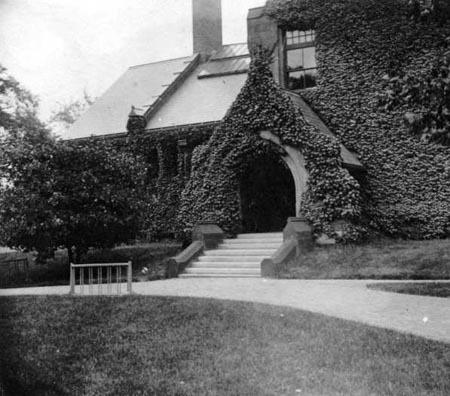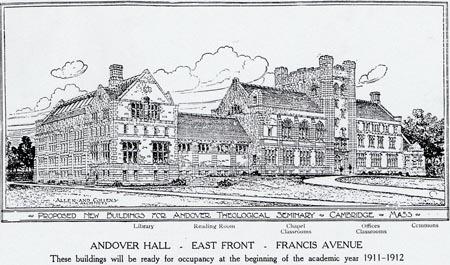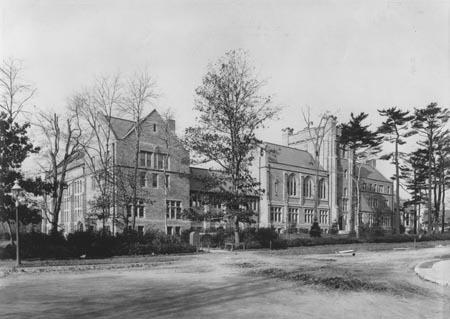Building Projects
The New Library
The school's first separate library building was constructed in 1886-87 near Divinity Hall. Designed by the Boston architectural firm of Peabody and Stearns, it had thick brick walls with brownstone trimmings and Gothic ornamental details, iron staircases, gables and chimneys, and a masonry porch. When its building was proposed, Acting Dean Francis G. Peabody suggested it should be part of a "Divinity quadrangle." Today the building is part of the Harvard University Herbaria at 20 Divinity Avenue.
The following extracts from the annual HDS Dean's Reports chronicle the Library's progress:
Dean's Report, 1883/84: The number of bound volumes was found to be larger than previous estimates had indicated, owing to the fact that in former enumerations, pamphlets after being bound had still been reckoned as pamphlets and not as volumes. The card-catalogue increased slowly during the year and a beginning was made in a card subject-catalogue.
I canot omit reference to the generous donation by Mrs. Ezra of a large part of Dr. Abbot's library, the gift including nearly four thousand volumes. Mrs. Abbot, without making any formal condition upon which the gift depends, yet states in her letter of donation that she should be glad to be assured of two things: first, that the collection shall be kept, under the title of the Ezra Abbot Library, so far intact as is consistent with its usefulness; second, that there shall be secured as soon as possible for this collection, and for the rest of the Divinity School library, a more adequate and safe place of deposit. The nature of the collection will probably make it easy to fulfil to a large extent the first of these requests. The second brings to light a need of the School that has been long felt and which is made by this gift more pressing, that of a fire-proof library distinct from Divinity Hall, but easily accessible from it. This is important for the preservation of our books, for the encouragement of future donations, and for making possible the transferance from Gore Hall of volumes important to students of Theology. Such transferance is made to some departmental libraries to the great advantage of students in these departments. It cannot be done in the case of Divinity library, as the risk from fire is too great.
Among the donations received during the last year may be men-tioned an anonymous gift of $750, and a gift of $450 from George S. Hale, Esq. This latter amount is, at the request of Mr. Hale, devoted to the purchase of books for the library.
Dean's Report, 1884/85: The Progress of the Scheme for a New Library Building
This demand, it will be remembered, was made imperative by the gift of the Ezra Abbot library. During the past year satisfactory plans have been secured, the estimates for which amount to $35,000. Individual subscriptions, and the gift of the Society for Promoting Theological Education, have reached a sum within ten thousand dollars of the amount needed, and it is safe to hope that the building will be erected during the summer of 1886. It seems best to urge, however, that this is not the end of the expenditure on buildings which the School immediately needs. It is absolutely necessary that Divinity Hall should be so renovated as to make it a modern and attractive building. The Divinity School deserves to be as well housed as the rest of the University, and it is at present in great contrast with all other departments. It should be, in my opinion, the purpose of the Corporation to utilize for the Divinity School the square of ground which lies behind Divinity Hall, and to develop it into a quadrangle of the same general form as the quadrangle of the Agassiz Museum. Of this space, Divinity Hall would form the front, the new library building should be the north side and would be connected with Divinity Hall by a covered passage. On the south side should be placed a new and more commodious chapel, and the rear should be for the present left open to the woods beyond. (Francis G. Peabody, Acting Dean)
Dean's Report, 1885/86: The most marked event of the year was the laying the foundation of a new building to contain fire-proof accommodation for the library, a reading-room and lecture-rooms. The generosity of the friends of the School which made this erection possible is most gratefully acknowledged. A list of gifts and donors will be found in the Treasurer's report. Special mention should be made, however, of the great service rendered by the Society for Promoting Theological Education. This society, to which the School has been so much indebted from the time of its first independent existence, entered most heartily into the work, made a generous appropriation of the funds that are in its hands, and appointed a committee of its members, who cooperated effectually with the acting Dean in his energetic and successful efforts to raise the money necessary for this building. The commencement of the work was delayed by the disturbances in labor which in the last year interrupted so much of the business of the country, but it will probably be completed during the current year. ...
The Librarian reports an addition to the library during the year of 539 volumes; 380 volumes were, however, sold during the year, these being duplicate copies which were not needed. The net increase in volumes is thus 180. By this sale the sum of $150 was realized, which will be expended in the purchase of new books. The library contains at present 17,569 volumes and 2308 pamphlets. This statement does not include nearly 4000 volumes, which formed a part of the library of the. late Professor Ezra Abbot, and which, as was stated in a former report, were presented to the Library of the Divinity School by Mrs. Abbot. Although these books belong to the library they cannot actually form a part of it until the building now in process of construction shall be completed.
Dean's Report, 1887/1888: In 1887-88 the School enjoyed for the first time the use of the new library building. It proved both pleasant and convenient, and now appears to have been indispensable to the best work of the School. The use of the library has increased at least three-fold since the change.
By the erection of the new building, the space in Divinity Hall that had been given up to the library and to lecture rooms was set at liberty. With the exception of the Chapel, Divinity Hall is now entirely used for students' chambers. By the change six additional room are gained, and one room that, had ben encroached upon by a lecture room was restored to its original proportions. The addition to the rent of the building that comes from these sources is $350. ...
The removal of the library to the new building made imperative what had long been desirable, a new arrangement and cataloguing of the books. The last year all the books were classified and arranged upon the shelves in accordance with the classification. They were also relabeled within and without. All needful preparations were made for commencing a card-catalogue this year. The School is indebted to the experience, ingenuity, and efficiency of the librarian, D. J. H.. Ward, Ph.D., for much of the success with which these changes have been accomplished. Professor Thayer, the chairman of the Library Committee, has also given much time and thought to the matter.
Dean's Report, 1888/89: The new library proved itself even more useful than in the preceding year. During the latter part of the year it was open in the evening, as well as during the day, and was largely frequented. The use of this room has been extended to College students taking Divinity School courses, for which no books are reserved in Gore Hall; to clergymen resident in Cambridge, and to students in the Episcopal Theological School. This last provision was made in response to a petition from two or three members of that School that they might be allowed to make such use of the library.
The "Faculty-room," which serves also as the Dean's office, proves a great convenience. The Dean is there at a certain time every day; and the room being directly opposite to the reading-room, it easy and natural for the students to have communication with him. The need is already felt, however, of a larger lecture-room, as it is very desirable that all the lectures which primarily belong to the Divinity School should be given in connection with it. The large attendance of College students renders this, in some cases, impossible. It would be well if there could be found a way to throw two of the lecture-rooms together when a larger hall is needed.
The School received the last year from Mr. Stephen Salisbury of Worcester a valuable gift of 65 Babylonian written tablets. Of such tablets there are now about 150 in the collection of the school, including six which belong to the University. It is greatly to be desired that these might serve as the nucleus of a Semitic Museum, in which Palestinian antiquities and other objects of interest should have a prominent place ...
The work of cataloguing was continued during the year. Though this involvrs an expenditure which the School at present can ill afford, it is a work of absolute necessity.
Dean's Report, 1889/90: Of the accessions 192 volumes and 1 pamphlet were purchased. The most important gift of the year was that of 47 volumes by bequest of Rev. William Silsbee. This was increased by the gift of 22 volumes made by his widow from his library. Books and pamphlets (of the latter 1383) were given by Mrs. Henry W. Foote from the library of her late husband. Similar gifts from the library of Dr. Hedge were made by his children. 30 volumes and 43 pamphlets were received from the American Unitarian Association, through which gift we have all of the publications of this Association which are now in print.
The important work of cataloguing the Library has been diligent carried on during the year. The object of the catalogue is not merely to enable a person to obtain books, the titles and authors of which., knows, but also to make it possible for any one wishing to consult Library in regard to any topic to learn what is the help which Library can give him. Books are thus catalogued, not only as title and author; there is also given, so far as important books and subjects are concerned, some analysis of their contents. To take and obvious example, one studying in regard to the authorship of the fourth Gospel might perhaps have no idea that in Ezra Abbot's "Critical Essays" is contained one of the most important discussions of this subject. In the new catalogue, under the appropriate heading, reference will be made to this and to other discussions that are worth consulting. This analysis obviously requires to be made very fully and with great judgment. It requires, also, learning both general and special. We are fortunate in having to conduct this work a librarian so well fitted for it as Robert S. Morison, A.M., a graduate of the School. This work involves an expenditure which the School is hardly able to bear, but the need is so pressing that the work cannot be deferred. From the nature of the case the process is a slow one, especially as those engaged in it have other duties in connection with the Library. During the year 3180 volumes were cataloged.
The greater part of the use of the Library is that of the reserved books in the reference room; of this no statistics can be given. From October 1st, 1889, to June 30th, 1890, there were taken from stack 758 volumes, and from the reserved books, for use over night, 665 volumes. There was a tolerably steady increase, month by month, in the number of books borrowed from the stack. The number of such books in October this year was more than a third larger than that in October, 1889.
In my last report reference was made to the value of objects illustrating Biblical subjects. Since that time a gift of money has been announced from Mr. Jacob H. Schiff to the University for the beginning of a Semitic museum. While this museum will have no organic connection with the School, its resources will always be at the service of Divinity Students, and cannot fail to increase interest among us in the study of the Bible. The School may congratulate itself on having within easy reach collections so intimately connected with Biblical peoples and history.
See also: "The Harvard Divinity School Library." Library Journal, v. 13, no. 2 (Feb. 1888), p. 42-43. Reprinted from the Christian Register.
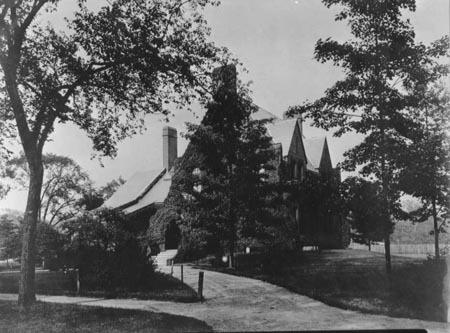
Renovating Divinity Hall
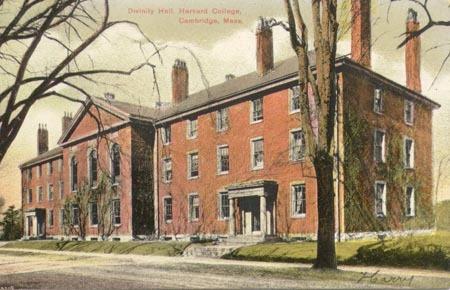
Divinity Hall was dedicated on August 29, 1826. In the later part of the 19th century various renovations are mentioned in the HDS Dean's Reports. In 1882/83: "Summer before last the chapel was refurnished and decorated ... [This] last summer ... the entries have been made much brighter ... and ... the vestibules have been enlarged. ... the field at the north of the building has been levelled. This ... will in time furnish a very convenient place for out-of-door sports." In 1892/93: "Steam heat has been introduced ... into the hallways and the Chapel and excellent bathrooms have been added on the two lower floors ...."
 |
|
Divinity Hall Chapel
|
In 1904, the Chapel was completely renovated. The architect was A.W. Longfellow, Jr. (1854-1934), nephew of the poet Henry Wadsworth Longfellow. After graduating from Harvard, he entered the new architecture program at the Massachusetts Institute of Technology. After additional study in Paris in 1879-1881, he apprenticed with H. H. Richardson. From 1886 to 1896, he was in partnership with Frank Alden and Alfred Harlow in a firm that designed in both Boston and Pittsburgh. From 1896 to 1923, he worked on his own. In Boston he designed the now demolished stations on the elevated railroad (1898/1902) and the elegant Eben Draper House on Beacon Street (1904); he redesigned the apse and pulpit of the Arlington Street Church (1910). He designed Phillips Brooks House (1897-1899) and the Semitic Museum (1902) at Harvard and Agassiz House (1904) and Bertram Hall (1901) at Radcliffe. He designed Winthrop Hall (1892) at the Episcopal Theological (now Divinity) School and many houses in the Brattle Street neighborhood. He was active in the Boston Architectural Club and the Boston Society of Arts and Crafts. Longfellow was featured in Margaret Henderson Floyd's recent book Architecture after Richardson (Chicago: University of Chicago Press, 1994).
HDS Dean's Report, 1903/04: Divinity Hall has been much improved during the year. The renovation of the Chapel has been completed, and it is now a dignified and beautiful place of worship. Tablets of marble or oak have been set, in the walls in memory of Professor Hedge, Professor Thayer, and the Rev. Edmund Sears, and to recall the delivery in the Chapel of Ralph Waldo Emerson's Divinity School Address. To these are soon to be added memorials of Dean Everett and Professor Henry Ware, Jr. There has also been added to the equipment of Divinity Hall a modern bathroom with four slate-lined shower baths, and the hallway floors have been in part relaid. These changes, together with the provision of the Common Room for all occupants of the Hall, tennis courts at the rear, and the advantages of the Library and Reading Room, have made Divinity Hall one of the most attractive dormitories in the University. An instructive experiment has been undertaken in reserving the right of occupancy to students approved by the Dean, with a preference given to graduate students and professional students having some sympathy with the purpose of the School, and the result is the creation of a congenial group of mature men, who find in the building a pleasant Centre of companionship. It seems not unreasonable that a similar plan, which may give to each dormitory or group of dormitories a certain stamp of interest or sympathy, might be applied to other Schools of the University with success.
HDS Dean's Report, 1898/99: During the last summer two changes were made in Divinity Hall from which good results are anticipated. Twenty rooms were supplied with simple and substantial furniture, a small addition being made to the rent of each. The furnishing of these rooms seemed especially desirable from the fact that so many of our students come only for a year. The other change referred to was the arrangement of what will be known as the "Common Room." The partition between two rooms was taken away and they were redivided so as to form a larger and a smaller room opening into one another by large doors. The smaller room will be used as a reading room, and the larger for social purposes. The rooms are furnished in an attractive manner. This arrangement was made possible by money given to the President and Fellows of Harvard College, shortly after his graduation from the school in 1872, by Rev. John William Quinby. This money was to be expended under the direction of the Faculty of the Divinity School; and it seemed to that body that no expenditure of a portion of it, together with the interest that had accumulated, could be more useful to the school and more honorable to the giver than this. An inscription will commemorate the generosity that made this extremely pleasant feature of the school possible.
HDS Dean's Report, 1901/02: The Divinity School is the only department in the University having its own dormitory. This fact has, however, not always been to the advantage of the School. Divinity students have found themselves segregated from the main movement of university life, and since Divinity Hall is an inexpensive lodging-place, rooms not occupied by Divinity students have, as a rule, been taken by College students who were willing to sacrifice comfort for economy. The building has thus for many years been in disfavor among many students of the University; and the school has borne the reputation of being the report of few who could live elsewhere. The brevity of a college tradition is illustrated by the fact that in a half-dozen years Divinity Hall has been transformed into one of the most popular dormitories, and is now occupied by a select and congenial colony. A pleasant Common-Room makes a meeting place for all occupants of the Hall, a large bath-room with four slate compartments for shower-baths, and a reserved tennis court are provided; and application for residence by students not members of the School must be approved by the Dean. Students of the Graduate School and the professional schools are preferred in these applications, which are now in excess of the capacity of the Hall. The establishment of a social center within a dormitory, and the giving of a specific character to dormitory life, is not without instructiveness for the administration of other University buildings.
Building Andover Hall (now Swartz Hall)
Despite the alienation of a century earlier, bonds between the Andover Theological Seminary and the Harvard Divinity School had grown stronger through the years, and by 1906, when Andover felt a decline in attendance and a lack of resources, the Seminary entered into consultation with Harvard University about a possible affiliation and a plan of affiliation was agreed upon in 1908. The Seminary built Andover Hall, which was completed in 1911 at a cost of $300,000. It was designed by the firm of Allen and Collens, which specialized in ecclesiastical and neo-medieval designs. They also designed Riverside Church (1930) and The Cloisters (1938) in New York City. After the plan of affiliation was dissolved, Harvard bought Andover Hall in 1935.
When it was built, Andover Hall contained a library, lecture and seminar rooms, a chapel, professors' studies, administrative offices, and dormitory rooms. The style is called "Collegiate Gothic"; it is Harvard's only example of this style.
Address of President Fitch and Secretary Platner Andover Theological Seminary, Cambridge, Massachusetts:
Two years have passed since Andover Theological Seminary, after one hundred years of useful service on Andover Hill, was removed to Cambridge. In that time it has adjusted itself to its new surroundings, purchased a valuable tract of land, and laid the corner stone of its commodious and beautiful building, which it hopes to occupy by the autumn of 1911.
The experience of these two years and the present outlook have convinced those who are most intimately associated with the Seminary that the removal was wise, and that the prospects for increasing usefulness are most encouraging.
By the terms of affiliation agreed upon by the Trustees of the Seminary and the Corporation of Harvard University, the Trustees and Visitors retain entire control of the Seminary; they appoint and confirm the professors and administer all the trusts. The Seminary is to have its own chapel and lecture rooms, and conduct, so far as seems desirable its own religious services and social and religious organizations.
At the same time the relation established with the University grants to the Andover professors the opportunity of giving instruction to students enrolled in the Divinity School and other departments of the University, thus increasing the size and interest of their classes and enlarging the sphere of their influence. The Andover students also have the privilege of taking courses in the classes of Harvard professors, thus securing a variety and completeness of educational facilities which could never be provided in a country village.
By a mutually satisfactory arrangement, the libraries of the Seminary and the Divinity School are to be combined and placed in the Andover building. This will be a bond of union between the two schools and will provide one of the most complete theological libraries in the country.
The teachers and students of the Seminary have been cordially invited to share in the religious services and work of the University, and the churches and religious and charitable societies in Cambridge, Boston, and neighboring cities and towns offer many opportunities for Christian culture and Christian service.
President George Harris, D.D.LL.D., Amherst, President of the Board of Trustees
Albert Parker Fitch, D.D., President of Faculty
John Winthrop Platner, D.D., Secretary of the Faculty
Architectural sketch and address of Fitch and Platner from: Boston, a Guide Book, by Edwin M. Bacon. Boston: Ginn, special revised edition, Sept. 1910, prepared for the 14th session of the National Council of Congregational Churches. Boston: Ginn & Company, 1903.



